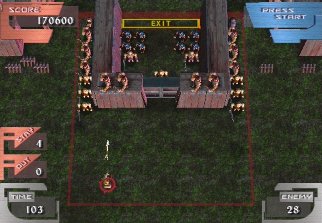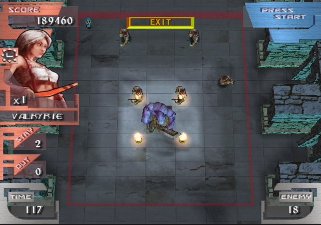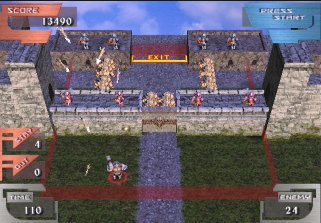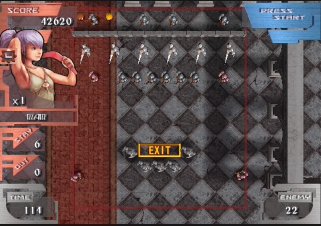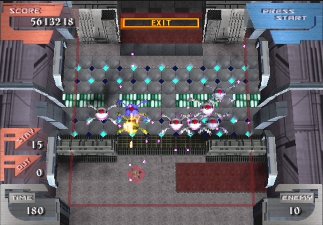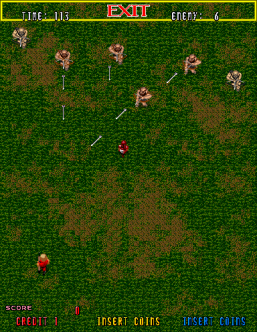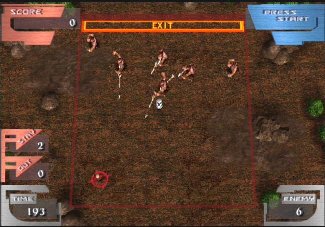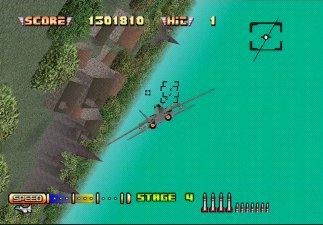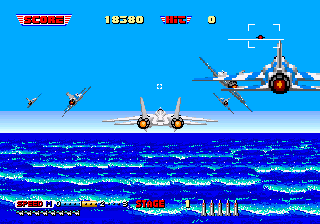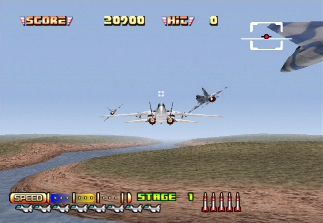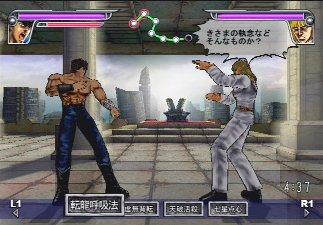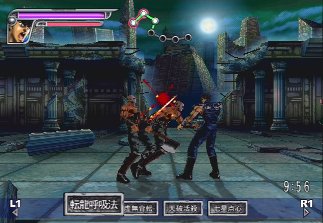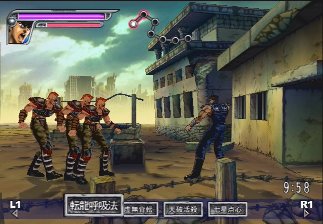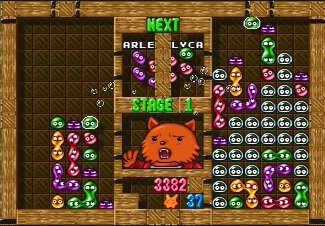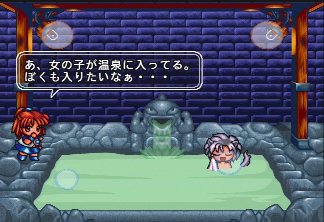
|
Page 1: |
Page 2: |
Page 3: |
Page 4: |
|
|
Page 5: |
Page 6: |
Page 7: |
Page 8: |
Sega Ages 2500 Vol. 9: Gain Ground (SEGA AGES 2500 シリーズ Vol.9 ゲイングランド) - PlayStation 2 (2004)
What is it? - A self described "algorithm action game", Gain Ground might look like Commando, but adds a small dose of strategy. Control over thirty different characters from different time periods, including vikings, robots, valkyries, samurais, knights and others, each with various abilities. Read the full article.
About the Sega Ages version - Gain Ground was never a particularly pretty game, full of browns and greys and dark greens, and the new 3D graphics don't really improve on things. Each character has brand new artwork, most of which are pretty cool, and for the first time, it displays their name in English. The characters themselves look slightly super deformed, and the goofy egg-shaped renditions of the captured units are pretty amusing. There are three different camera perspectives, ranging from the traditional overhead to an angled perspective, which isn't particularly useful except for when judging the height of terrain or projectiles. Like the other home ports, the levels have been shrunken so everything fits all on one screen, and the three-player mode has been reduced to two. But otherwise this is pretty accurate to the arcade version, including an option to disable a bug in stage 4-8 which makes it impossible to clear the stage, requiring that you (tediously) bring all of your characters to the exit. It is, however, lacking the extra stages from the Genesis version and the rebalanced difficulty from the PC Engine CD version, so it's still overly frustrating.
Gain Ground (PS2)
There's also an Extra Mode which features some slightly different graphic tile sets and altered character abilities. Unfortunately, accessing this requires beating the game on the default difficulty settings (Normal level, 120 seconds time limit.) Gain Ground is 40 stages long, and gives you unlimited continues right up until the last stage. Plus, if you haven't saved the right characters, the final boss is incredibly difficult, so unlocking this mode is only for the most hardcore players. On the plus side, it opens up what is probably this releases' greatest asset - the music. The entire soundtrack has been provided courtesy of awesome music group Saitama Saisyu Heiki (also known as S.S.H.), who does some damn amazing stuff with his synth guitars. All of the arcade music has been rearranged in this style, but the Extra Mode features a whole ton of brand new tracks.
Worth it? - Gain Ground is definitely a love-it-or-hate-it kind of game, so I can't recommend it unequivocally. However, it has a bit more depth than a lot of the other early Sega Ages releases - which, despite being a lot of fun, are fairly disposable. And this is probably the closest you can get to the arcade version, so it's probably worth snagging.
Quick Info:
Developer:
Publisher:
Genre:
Themes:
Gain Ground (PS2)
Gain Ground (PS2)
Gain Ground (PS2)
Comparison Screenshots
Sega Ages 2500 Series Vol. 10: After Burner II (SEGA AGES 2500 シリーズ Vol.10 アフターバーナー) - PlayStation 2 (2004)
What is it? - A 3D shooter where you pilot a jet across several stages, blow up enemies and dodge missiles. Very much Top Gun: The Video Game, except much better than any actual Top Gun video game. Read the full article.
About the Sega Ages version - It might look ugly in the pictures, but in motion, the PS2 version is silk smooth and moves blazingly fast. So while the graphics are very cheap - like Space Harrier - the polygonal graphics do a better job of simulating 3D than the scaling sprites of the arcade version. It plays well enough, although the option of unlimited continues may make it too easy for some. Unfortunately none of the music is remixed, as at all it is taken from the arcade version. The sound test offers several different variations from each of the arcade iterations (the first After Burner had the same songs but sounds a bit different) but there doesn't appear to be a way to use them in-game. The "Arrange" mode allows you to choose from four planes - in addition to the F-14, there's also a harrier, a bomber and a stealth fighter. These just seem to be different models and don't actually affect the controls or game in any way.
Worth it? - In the past, After Burner has usually shown up on classic compilations, so it's weird that it was missing from the Sega Classics Collection release. As a standalone purchase, it's a bit more questionable, since there's nothing really added this time. Still worth it if you dig After Burner though.
Links:
Kikizo Games
The Games Database
Quick Info:
Developer:
Publisher:
Genre:
Themes:
After Burner II (PS2)
After Burner II (PS2)
Comparison Screenshots
What is it? - A side scrolling fighting game based off the classic manga/anime Fist of the North Star. The original was released on the Mark III/Master System in 1986, and was drastically overhauled to become Black Belt for Western audiences. (The binder card that comes with it seem to paint the game as the brainchild of Yuji Naka, way back before he got involved with Sonic.) It's pretty much just a variation of Irem's Spartan X / Kung Fu, except the bad guys awesomely shatter when you hit them. Read the article here about the differences between Hokuto no Ken and Black Belt.
About the Sega Ages version - Hokuto no Ken is more of a reimagining of the original version rather than a remake - and man, does it suck. The original Mark III version was shallow, but still a bit fun - this one is sluggish and boring. Despite using 3D graphics, it's still a 2D brawler, although you can only walk left and right, and not up and down like Double Dragon and other beat-em-ups. There are still two primary attack buttons, although they're just "light" and "heavy" as opposed to "punch" and "kick" of the original version. As you destroy enemies, you build your power gauge. By selecting one of four attacks with the shoulder button, you can execute a variety of special manuevers.
Despite the extra moves, the controls themselves are much slower than the original version. The stages are rarely more than a few screens long, and you simply walk back and forth killing bad guys until the game is sick of throwing them at you. There are one-on-one boss duels, but while the original version required some interesting tricks to beat your foes, these are fair sloppier. Later in the game, you get to play as Rei and Toki, but they control mostly the same, just with less special moves. The graphics are surprisingly decent considering the quality of other early Sega Ages titles, as they utilize a cel shading technique that makes it look similar to the manga, but you literally fight variations of the same enemy over and over. Unfortunately, there's also a surprisingly lack of violence. Hokuto no Ken is known for exploding heads and bursting intestines, but other than some small blood splatters, there are very few cool death animations. What the hell? So really, the only good thing about this package is that it includes the original Mark III version.
Worth it? - The 3D remake takes something that was simple yet fun, and somehow mangles it completely. The Mark III game is fun at least, even though I would've liked to have seen Black Belt on here, if only for completion's sake. So if you really need a Hokuto no Ken game, just grab Arc System's 2D fighter (released three years after for the PS2 in 2007) and avoid this completely.
Quick Info:
Developer:
Publisher:
Genre:
Themes:
Hokuto no Ken (PS2)
Hokuto no Ken (PS2)
Hokuto no Ken (PS2)
Comparison Screenshots
Sega Ages 2500 Vol. 12: Puyo Puyo Tsuu Pefect Set (SEGA AGES 2500 シリーズ Vol.12 ぷよぷよ通パーフェクトセット) - PlayStation 2 (2004)
What is it? - Another Tetris clone, this time from Compile, where you match falling colored blobs to clear them from the board. The big difference it's focused on competitive play, so you're creating combos to beat your opponents instead of simply scoring points. Also stars lots of cutesy characters, most of which hail from old PC RPGs. Read the full article.
About the Sega Ages version - The 16-bit versions (Genesis and SNES) of this game were pretty much straight ports of the arcade version, while the 32-bit releases (PlayStation and Saturn) added a bunch of extras. Perfect Set builds on that ever further - altogether, it features the standard single player mode, a super quest mode filled with 36 different opponents, fully voiced pre-battle cinemas featuring the main character Arle facing off the other goofy cast members, and a Nazo Puyo mode, a puzzle mode where you're given a screen prefilled with blobs and need to beat certain tasks. Also included is a mediocre arranged soundtrack (the original arcade music is available thankfully) and high-res 2D graphics, although they're pretty much just upscaled and run through a filter to smooth out the edges, like you'd see through an emulator. Disappointingly, the Omake (bonus) mode only includes promo videos of the other Sega Ages titles.
Worth it? - Puyo Puyo 2 is arguably the "purest" of the series, before it started getting cluttered up with gimmicks like sun puyos, special abilities and fever modes. Still, even though this was Puyo Puyo's first appearance on the PS2, it's doubtful it was worth it even back then, while the other versions are so much cheaper. Just get Puyo Puyo Fever or Puyo Puyo 15th Anniversary and turn off the more annoying features - only get this if you REALLY need the classic graphic style.
Quick Info:
Developer:
Publisher:
Genre:
Theme:
Puyo Puyo Tsuu Perfect Set (PS2)
Puyo Puyo Tsuu Perfect Set (PS2)
Comparison Screenshots
What is it? - A self described "algorithm action game", Gain Ground might look like Commando, but adds a small dose of strategy. Control over thirty different characters from different time periods, including vikings, robots, valkyries, samurais, knights and others, each with various abilities. Read the full article.
About the Sega Ages version - Gain Ground was never a particularly pretty game, full of browns and greys and dark greens, and the new 3D graphics don't really improve on things. Each character has brand new artwork, most of which are pretty cool, and for the first time, it displays their name in English. The characters themselves look slightly super deformed, and the goofy egg-shaped renditions of the captured units are pretty amusing. There are three different camera perspectives, ranging from the traditional overhead to an angled perspective, which isn't particularly useful except for when judging the height of terrain or projectiles. Like the other home ports, the levels have been shrunken so everything fits all on one screen, and the three-player mode has been reduced to two. But otherwise this is pretty accurate to the arcade version, including an option to disable a bug in stage 4-8 which makes it impossible to clear the stage, requiring that you (tediously) bring all of your characters to the exit. It is, however, lacking the extra stages from the Genesis version and the rebalanced difficulty from the PC Engine CD version, so it's still overly frustrating.
Gain Ground (PS2)
There's also an Extra Mode which features some slightly different graphic tile sets and altered character abilities. Unfortunately, accessing this requires beating the game on the default difficulty settings (Normal level, 120 seconds time limit.) Gain Ground is 40 stages long, and gives you unlimited continues right up until the last stage. Plus, if you haven't saved the right characters, the final boss is incredibly difficult, so unlocking this mode is only for the most hardcore players. On the plus side, it opens up what is probably this releases' greatest asset - the music. The entire soundtrack has been provided courtesy of awesome music group Saitama Saisyu Heiki (also known as S.S.H.), who does some damn amazing stuff with his synth guitars. All of the arcade music has been rearranged in this style, but the Extra Mode features a whole ton of brand new tracks.
Worth it? - Gain Ground is definitely a love-it-or-hate-it kind of game, so I can't recommend it unequivocally. However, it has a bit more depth than a lot of the other early Sega Ages releases - which, despite being a lot of fun, are fairly disposable. And this is probably the closest you can get to the arcade version, so it's probably worth snagging.
Quick Info:
|
Developer: |
|
|
Publisher: |
|
|
Genre: |
|
|
Themes: |
Gain Ground (PS2)
Gain Ground (PS2)
Gain Ground (PS2)
Sega Ages 2500 Series Vol. 10: After Burner II (SEGA AGES 2500 シリーズ Vol.10 アフターバーナー) - PlayStation 2 (2004)
What is it? - A 3D shooter where you pilot a jet across several stages, blow up enemies and dodge missiles. Very much Top Gun: The Video Game, except much better than any actual Top Gun video game. Read the full article.
About the Sega Ages version - It might look ugly in the pictures, but in motion, the PS2 version is silk smooth and moves blazingly fast. So while the graphics are very cheap - like Space Harrier - the polygonal graphics do a better job of simulating 3D than the scaling sprites of the arcade version. It plays well enough, although the option of unlimited continues may make it too easy for some. Unfortunately none of the music is remixed, as at all it is taken from the arcade version. The sound test offers several different variations from each of the arcade iterations (the first After Burner had the same songs but sounds a bit different) but there doesn't appear to be a way to use them in-game. The "Arrange" mode allows you to choose from four planes - in addition to the F-14, there's also a harrier, a bomber and a stealth fighter. These just seem to be different models and don't actually affect the controls or game in any way.
Worth it? - In the past, After Burner has usually shown up on classic compilations, so it's weird that it was missing from the Sega Classics Collection release. As a standalone purchase, it's a bit more questionable, since there's nothing really added this time. Still worth it if you dig After Burner though.
Links:
Kikizo Games
The Games Database
Quick Info:
|
Developer: |
|
|
Publisher: |
|
|
Genre: |
|
|
Themes: |
After Burner II (PS2)
After Burner II (PS2)
What is it? - A side scrolling fighting game based off the classic manga/anime Fist of the North Star. The original was released on the Mark III/Master System in 1986, and was drastically overhauled to become Black Belt for Western audiences. (The binder card that comes with it seem to paint the game as the brainchild of Yuji Naka, way back before he got involved with Sonic.) It's pretty much just a variation of Irem's Spartan X / Kung Fu, except the bad guys awesomely shatter when you hit them. Read the article here about the differences between Hokuto no Ken and Black Belt.
About the Sega Ages version - Hokuto no Ken is more of a reimagining of the original version rather than a remake - and man, does it suck. The original Mark III version was shallow, but still a bit fun - this one is sluggish and boring. Despite using 3D graphics, it's still a 2D brawler, although you can only walk left and right, and not up and down like Double Dragon and other beat-em-ups. There are still two primary attack buttons, although they're just "light" and "heavy" as opposed to "punch" and "kick" of the original version. As you destroy enemies, you build your power gauge. By selecting one of four attacks with the shoulder button, you can execute a variety of special manuevers.
Despite the extra moves, the controls themselves are much slower than the original version. The stages are rarely more than a few screens long, and you simply walk back and forth killing bad guys until the game is sick of throwing them at you. There are one-on-one boss duels, but while the original version required some interesting tricks to beat your foes, these are fair sloppier. Later in the game, you get to play as Rei and Toki, but they control mostly the same, just with less special moves. The graphics are surprisingly decent considering the quality of other early Sega Ages titles, as they utilize a cel shading technique that makes it look similar to the manga, but you literally fight variations of the same enemy over and over. Unfortunately, there's also a surprisingly lack of violence. Hokuto no Ken is known for exploding heads and bursting intestines, but other than some small blood splatters, there are very few cool death animations. What the hell? So really, the only good thing about this package is that it includes the original Mark III version.
Worth it? - The 3D remake takes something that was simple yet fun, and somehow mangles it completely. The Mark III game is fun at least, even though I would've liked to have seen Black Belt on here, if only for completion's sake. So if you really need a Hokuto no Ken game, just grab Arc System's 2D fighter (released three years after for the PS2 in 2007) and avoid this completely.
Quick Info:
|
Developer: |
|
|
Publisher: |
|
|
Genre: |
|
|
Themes: |
Hokuto no Ken (PS2)
Hokuto no Ken (PS2)
Hokuto no Ken (PS2)
Sega Ages 2500 Vol. 12: Puyo Puyo Tsuu Pefect Set (SEGA AGES 2500 シリーズ Vol.12 ぷよぷよ通パーフェクトセット) - PlayStation 2 (2004)
What is it? - Another Tetris clone, this time from Compile, where you match falling colored blobs to clear them from the board. The big difference it's focused on competitive play, so you're creating combos to beat your opponents instead of simply scoring points. Also stars lots of cutesy characters, most of which hail from old PC RPGs. Read the full article.
About the Sega Ages version - The 16-bit versions (Genesis and SNES) of this game were pretty much straight ports of the arcade version, while the 32-bit releases (PlayStation and Saturn) added a bunch of extras. Perfect Set builds on that ever further - altogether, it features the standard single player mode, a super quest mode filled with 36 different opponents, fully voiced pre-battle cinemas featuring the main character Arle facing off the other goofy cast members, and a Nazo Puyo mode, a puzzle mode where you're given a screen prefilled with blobs and need to beat certain tasks. Also included is a mediocre arranged soundtrack (the original arcade music is available thankfully) and high-res 2D graphics, although they're pretty much just upscaled and run through a filter to smooth out the edges, like you'd see through an emulator. Disappointingly, the Omake (bonus) mode only includes promo videos of the other Sega Ages titles.
Worth it? - Puyo Puyo 2 is arguably the "purest" of the series, before it started getting cluttered up with gimmicks like sun puyos, special abilities and fever modes. Still, even though this was Puyo Puyo's first appearance on the PS2, it's doubtful it was worth it even back then, while the other versions are so much cheaper. Just get Puyo Puyo Fever or Puyo Puyo 15th Anniversary and turn off the more annoying features - only get this if you REALLY need the classic graphic style.
Quick Info:
|
Developer: |
|
|
Publisher: |
|
|
Genre: |
|
|
Theme: |
Puyo Puyo Tsuu Perfect Set (PS2)
Puyo Puyo Tsuu Perfect Set (PS2)
|
Page 1: |
Page 2: |
Page 3: |
Page 4: |
|
|
Page 5: |
Page 6: |
Page 7: |
Page 8: |

